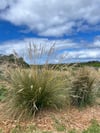Poa poiformis - Coastal tussock-grass
Poa poiformis - Coastal tussock-grass
Coastal Tussock Grass (Poa poiformis) is a resilient native Australian plant known for its distinctive habit and adaptability to coastal environments. It thrives along sandy shores, dunes, and coastal heathlands, making it an ideal choice for gardens located near the coast.
IUCN Conservation Status:
As of the latest assessment, Coastal Tussock Grass is not listed on the IUCN Red List, indicating that it faces no significant conservation threats. Its resilience and ability to thrive in coastal conditions contribute to its stability within its native habitat.
Place in Local Habitat and Ecosystem Distribution:
Coastal Tussock Grass plays a crucial role in maintaining the stability of coastal ecosystems. It forms dense clumps that help stabilize sand dunes, prevent erosion, and create a habitat for various coastal organisms.
Planting Companions:
When considering planting companions for Coastal Tussock Grass, look for other native coastal plants such as Leptospermum species, Carpobrotus species, and Acacia uncifolia. These selections can create a cohesive coastal-themed garden that thrives in the unique conditions of coastal environments.
Human and Wildlife Uses:
Historically, Coastal Tussock Grass had significant traditional uses among Indigenous Australian communities. The leaves of this grass were skillfully woven into baskets, mats, and other objects used for carrying and storage. This practical and artistic tradition underscores the connection between Indigenous cultures and the land. From a wildlife perspective, the dense tussocks of this grass offer shelter and nesting sites for various bird species. Additionally, the seeds provide a valuable food source for small mammals and insects, enhancing the local ecosystem's diversity. I believe the oldest known bread was made of a poa species.
Care Instructions:
To successfully introduce Coastal Tussock Grass to your garden, choose a well-drained, sandy soil, and ensure it receives ample sunlight. Regular watering during the establishment phase is crucial, and once established, the grass is relatively low-maintenance, thriving in the harsh conditions of coastal areas.
Size, Height, Width, Flower, and Leaf Characteristics:
Coastal Tussock Grass typically forms dense tufts, reaching a height of around 0.5 to 1 meter. Its flowering stems may extend slightly higher, producing delicate flower spikes. The grass's narrow leaves have a bluish-green hue, enhancing its coastal aesthetic.
Latin Etymology:
The genus name "Poa" derives from the Greek word for grass, reflecting its fundamental nature. The species name "poiformis" refers to its similarity in form to other species within the Poa genus.

